The cheesemaker's family’s home was in the same village, Xizhou, where we had endured the tacky tea ceremony. Arabic lettering on many signs told us that this was a predominantly Muslim village. The inhabitants, doubtless descended from the original northern invaders who conquered the area in China’s name in the time of Kublai Khan, or who perhaps ventured to Yunnan along the Southern Silk Road leading from India, look indistinguishable from Chinese and Bai people in their facial features, but we did notice that they did not wear Bai dress. Huang found out – even he hadn’t known this – that the dried cheese, called ru shan, is typically made by Muslim women, one of whom we were about to meet.
She greeted us from her home-based “dairy,” which consisted of one tiny and impeccably clean room adjacent to the stall where her cheese-making partner – the family cow – resided.
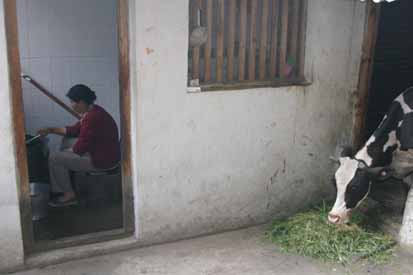 |
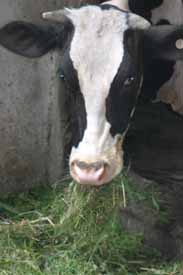 |
A row of bamboo rods, freshly-wrapped in minutes-old sheets of cheese, had been hung out to dry for half a day before sale.
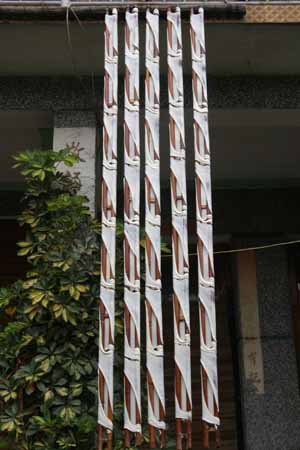 |
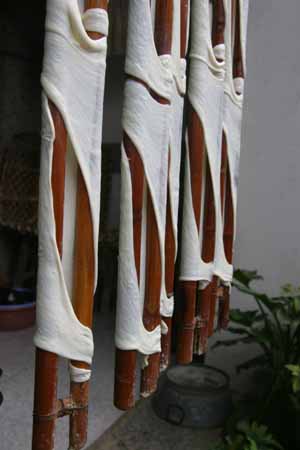 |
Ms. Li took a break from cheesemaking to show us the process from the start. She milks her prolific cow three times a day, and it was about time for the noon milking. She donned a hat, grabbed a stool, and took two buckets, freshly rinsed with boiling water, into the tiny stable. After carefully disinfecting the cow’s udder, she milked away, quickly producing about half a bucketful of steaming milk that she strained before setting it aside to cool.
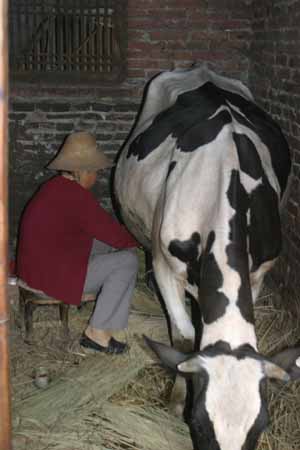 |
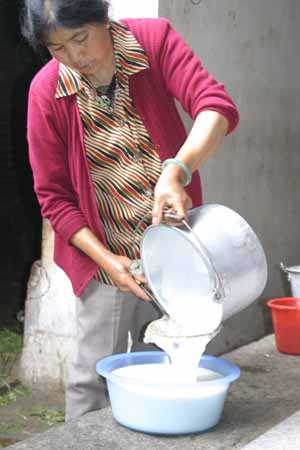 |
Back to cheese making. The process is simplicity itself, probably unchanged for many hundreds of years, although she is the first person in her family to make cheese for profit. In her wok, she heats up boiled water and splashes in a spoonful of liquid. Elsewhere, rennet or even lemon juice is used to catalyze the formation of curds from fresh milk, but her chemical agent is simply the whey, or leftover water, from yesterday’s cheese-making process. Sitting overnight sours it just enough to allow it to curdle the next day’s fresh milk.
| Here, you can see the bucket of fresh milk on her left. Behind the wok on her right is the container of souring agent. Between her legs, a third bucket will catch today’s leftover water, saved for tomorrow’s cheesemaking. | 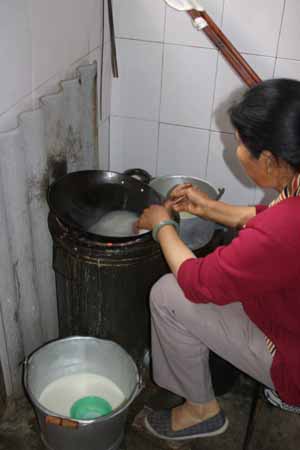 |
Making one piece of cheese takes about a minute. First, she adds a bowlful of fresh milk to the wok, then ladles in sour water. In just a few seconds, the heat and chemical reaction causes curds to form. |
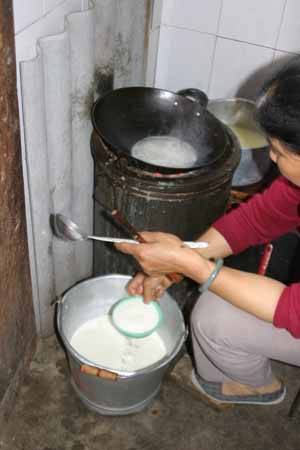 |
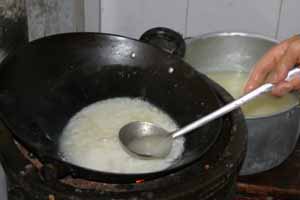 |
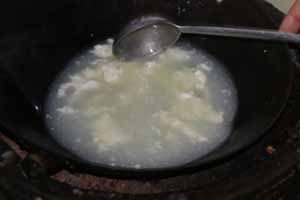 |
| She gathers the curds in a strainer, then pats them into a small ball, mopping it around the edges of the hot wok to pick up the remaining small curds. | 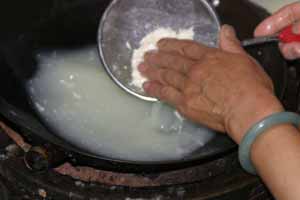 |
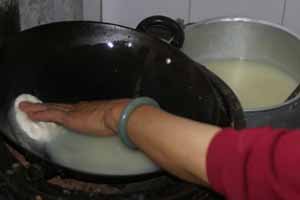 |
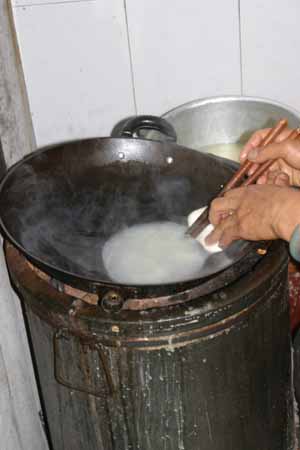 |
The tricky part – of course, it didn’t look tricky when she did it, only when I tried it myself – came next. She spent about 15 seconds rolling and flattening the patty, then stretching it between two sticks into a near-transparent sheet, which she then deftly wound around two large bamboo sticks for drying.
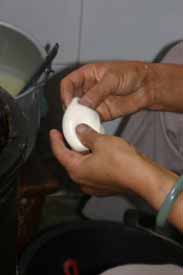 |
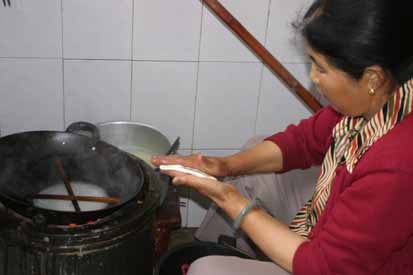 |
 |
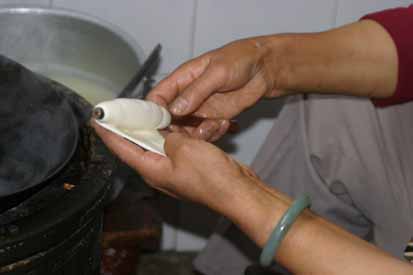 |
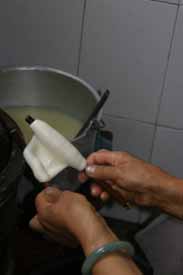 |
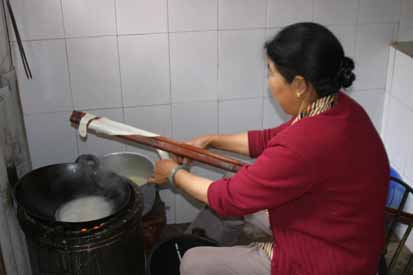 |
I was thrilled when she agreed to let me try it myself, and scrubbed like a surgeon at her outdoor sink. Adding the milk and water and making the curds proved simple, and even though I left a few scraps of curds floating in the water, I managed to make a respectable cheese patty – but the flattening and stretching proved to be beyond me.
 |
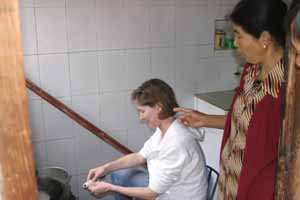 |
I tried several times to imitate her deft technique, but in the end, rather than attempt to add my uneven sheet to her sleek poles, I did the only reasonable thing left at that point and ate the sample myself – but not before posing with the source of the product.
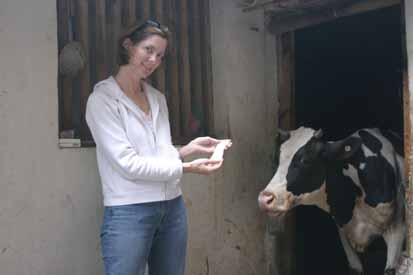 |
 |
Not surprisingly, it tasted like fresh mozzarella – which is of course is made in exactly the same way, though very rarely by hand these days! Not until after it’s dried and deep-fried does the cheese evince its nuttier characteristics. In the few moments it took me to enjoy the sample and ask her husband a few questions about the farm and the family income, the cheesemaker had filled up two more rods with sheets and added them to the drying rack.
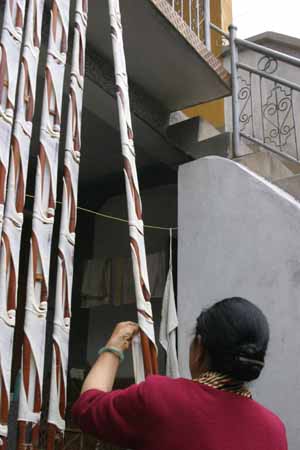 |
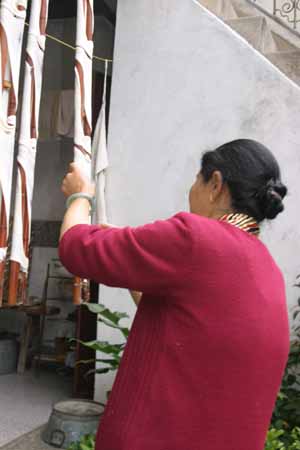 |
The husband said she makes about RMB 30 per day – that’s about $4 – from the cheese, which seemed at first like a very small return on what probably amount to an hour of labor, not counting the expenses of feeding the cow. But we also learned that a cow costs about RMB 1,500, and would produce about one calf per year for sale. Her vow had already dropped one calf and was not yet even fullly mature in terms of milk production – she would give even more milk in future years. Alll in all, a very tidy and profitable occupation.
I was thrilled to find a way to pursue my passion for cheese here, in Yunnan. In Beijing I’ve co-founded the Beijing Cheese Society to share my love of and ever-growing knowledge of cheese with others who share my interest. At our next meeting I’ll have something quite surprising to talk about!
Next: Wood Carving